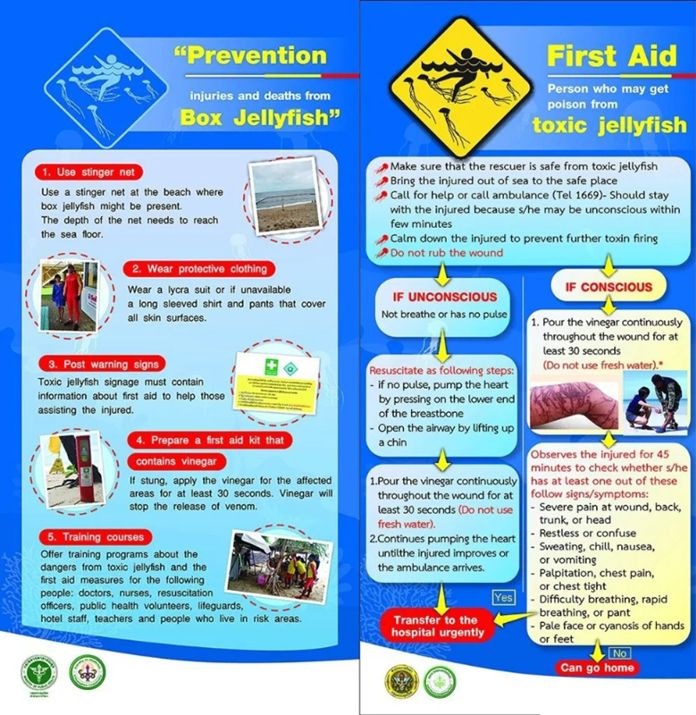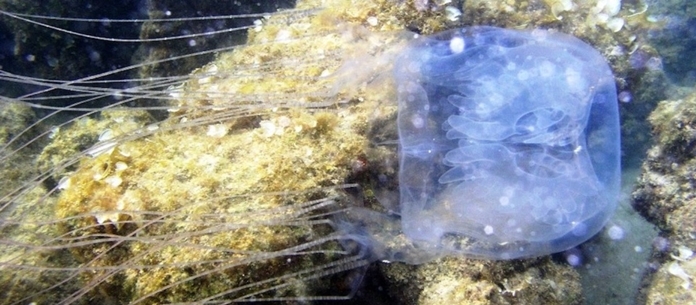
Bangkok– The Tourism Authority of Thailand (TAT) would like to advise tourists to be extra careful when swimming or snorkeling in Thai waters due to the season of venomous jellyfish, and not take any risks by entering waters where signs have been posted.
Measures are being taken in all of Thailand’s beach resorts to keep swimmers safe. Signs warning of the dangers of jellyfish have been erected and First Aid stations have been set up to deal with any person who might have been stung.
Do’s and Don’ts
-Always keep a look out for jellyfish warning signs that may be posted at a beach.
-Keep looking all around you when in the water and try to swim with a partner. A sting can often immobilize a person making it difficult to swim back to shore alone.
-To help prevent against jellyfish stings when swimming, wear a lycra suit or a long-sleeved shirt and pants that cover all skin surfaces.
-Beware of seemingly dead jellyfish on the beach. If they were recently beached, they can still sting.
-Do not swim if there are warning signs and always make sure of the location of the nearest First Aid centre before bathing.

First Aid steps for a suspected case of toxic jellyfish
If in contact accidentally with a toxic jellyfish or get stung, stay calm and try to remember to take these steps:
-Bring the injured person out of the sea to a safe place and immediately call an ambulance (Tel. 1669). Do not leave the person unattended.
-Calm the person down and make him/her remain still to prevent further spread of any toxin and do not rub the wound.
-Pour vinegar continuously over the wound for at least 30 seconds (do not use fresh water), which will initially help in most cases. Hotels, beach restaurants and diving outfits around Thailand have been ordered to keep bottles of vinegar easily accessible as part of their First Aid preparation. *It is a good idea to carry a bottle of vinegar with you.
-Observe the injured person for 45 minutes and watch for at least one of these signs/symptoms:
Severe pain on the wound, back, trunk or head.
Restlessness or confusion.
Sweating, chills, nausea or vomiting.
Palpitations, chest pain or chest tightness.
Breathing difficulty, rapid breathing or panting.
Pale face or bluish or purplish discoloration of the hands or feet.
-If the injured person is unconscious, perform CPR before pouring vinegar continuously over the wound for at least 30 seconds. Continue pumping the heart until the injured improves or the ambulance arrives.

-Do seek medical care if experiencing any ongoing symptoms.
While it is extremely rare for swimmers and divers in Thailand to be stung by jellyfish, we do ask that everyone planning to swim or dive, particularly in the Southern Region of the country, to be aware that there may be jellyfish present.
Several species of jellyfish, mostly harmless, can be found seasonally in Thailand. However, Box Jellyfish are sometimes found off the beaches of Ko Lanta and Hat Nopparatthara – Mu Ko Phi Phi National Marine Park off Krabi province, Nam Bo Bay in Phuket province and often off Hua Hin and Cha-am Beaches in Phetchaburi province, as well as Ko Tao in Chumphon province, Ko Samui, and Ko Pha Ngan in Surat Thani province. (tatnews.org)
 |
 |
 |





